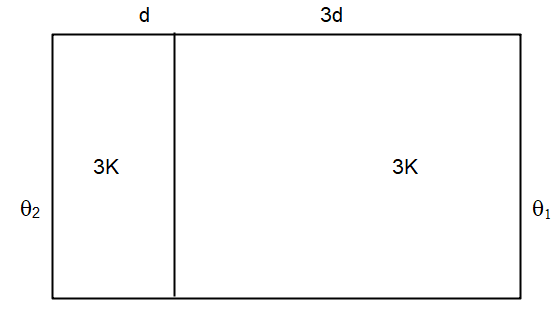
Two materials having coefficients of thermal conductivity ′3K′ and ′K′ and thickness 'd' and ′3d′, respectively, are joined to form a slab as shown in the figure. The temperature of the outer surfaces are

A)
B)
C)
D)

Answer
476.7k+ views
Hint : In this solution, we will assume that the system has been in a steady-state for a long time. Then both the slabs will have the same rate of heat transfer and we will use this to determine the solution of the interface.
Formula used: In this solution, we will use the following formula:
Rate of heat transfer in a slab with different temperatures:
Complete step by step answer
In the system given to us, we will assume that the system has been left in this situation for a long time. This implies that the heat transfer will have occurred over a long time and the system can be said to have achieved a steady-state.
In this steady-state situation, we can say that the heat transfer in both the slabs will be the same. Let us assume that the temperature of the surface is
Dividing both sides by
Solving for
Note
Unless mentioned otherwise, we must take such systems to be in a steady-state i.e. the system has been in this state for a long time. Only with this assumption can we assume that both the slabs will have the same rate of heat transfer.
Formula used: In this solution, we will use the following formula:
Rate of heat transfer in a slab with different temperatures:
Complete step by step answer
In the system given to us, we will assume that the system has been left in this situation for a long time. This implies that the heat transfer will have occurred over a long time and the system can be said to have achieved a steady-state.
In this steady-state situation, we can say that the heat transfer in both the slabs will be the same. Let us assume that the temperature of the surface is
Dividing both sides by
Solving for
Note
Unless mentioned otherwise, we must take such systems to be in a steady-state i.e. the system has been in this state for a long time. Only with this assumption can we assume that both the slabs will have the same rate of heat transfer.
Latest Vedantu courses for you
Grade 10 | CBSE | SCHOOL | English
Vedantu 10 CBSE Pro Course - (2025-26)
School Full course for CBSE students
₹37,300 per year
Recently Updated Pages
Master Class 11 Economics: Engaging Questions & Answers for Success

Master Class 11 Business Studies: Engaging Questions & Answers for Success

Master Class 11 Accountancy: Engaging Questions & Answers for Success

Master Class 11 English: Engaging Questions & Answers for Success

Master Class 11 Computer Science: Engaging Questions & Answers for Success

Master Class 11 Maths: Engaging Questions & Answers for Success

Trending doubts
State and prove Bernoullis theorem class 11 physics CBSE

1 ton equals to A 100 kg B 1000 kg C 10 kg D 10000 class 11 physics CBSE

State the laws of reflection of light

One Metric ton is equal to kg A 10000 B 1000 C 100 class 11 physics CBSE

1 Quintal is equal to a 110 kg b 10 kg c 100kg d 1000 class 11 physics CBSE

Difference Between Prokaryotic Cells and Eukaryotic Cells




